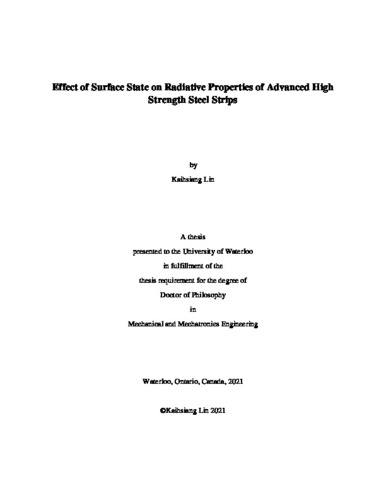UWSpace will be migrating to a new version of its software from July 29th to August 1st. UWSpace will be offline for all UW community members during this time.
Effect of Surface State on Radiative Properties of Advanced High Strength Steel Strips
| dc.contributor.author | Lin, Kaihsiang | |
| dc.date.accessioned | 2021-12-23 14:28:44 (GMT) | |
| dc.date.available | 2021-12-23 14:28:44 (GMT) | |
| dc.date.issued | 2021-12-23 | |
| dc.date.submitted | 2021-12-17 | |
| dc.identifier.uri | http://hdl.handle.net/10012/17812 | |
| dc.description.abstract | Automotive manufacturers increasingly turn to light-weighting through galvanized advanced high strength steels (AHSS) to improve fuel efficiency and reduce pollutant emissions without compromising passenger safety. Unfortunately, Canadian steel manufacturers report unacceptably high AHSS rejection rates due to substandard mechanical properties, both in terms of strength and zinc layer adhesion. Much of the issue can be traced back to temperature excursions during intercritical annealing, caused by improper heating control and errors in the pyrometrically-inferred temperatures used to control the furnaces. These errors, in turn, originate from the changing surface state of the steel strip, in terms of roughness and oxide formation, during thermal processing. This causes issues of steel heating control and wavelength-dependent variations in spectral emissivity, which are unaccounted for in the pyrometry measurement model. A large number of studies have been performed on correlating the surface state (e.g. oxide, roughness) and radiative properties of metals in the context of electromagnetic wave (EM) theory. The exact EM solution, along with other more approximate physical models, have been investigated to deal with the issue. Nevertheless, most of these studies are restricted to the modeling of bi-directional radiative properties, instead of wavelength-dependent spectral emissivity, which is critical to the improvement of heating control and pyrometry measurement. In addition, very few of these studies are related to AHSS, while none of them have been performed on correlating the surface state with radiative properties of AHSS subject to different alloy compositions and annealing conditions. As a consequence, the physical correlation between the surface state and radiative properties of AHSS still remain unclear. This study aims to improve the robustness of industrial pyrometry measurement and heating control of AHSS during continuous galvanizing, by determining how spectral emissivity depends on surface state, AHSS alloy composition, and annealing atmosphere. To achieve this, the relationship between AHSS surface topography and spectral emissivity is elucidated in the context of EM wave theory. First, the correlation between the surface roughness and radiative properties of several as-received and oxidized AHSS samples are investigated using the Davies’ model with wavelet-filtering technique. Secondly, the radiative properties of as-received AHSS having different surface topographies are interpreted using geometric optics approximation (GOA) ray tracing and EM diffraction models. Finally, the effect of alloy composition and annealing atmosphere on selective oxidation and radiative properties of AHSS having polished and as-received substrate states are interpreted via the thin film interference model and a hybrid thin film/geometric optics model, respectively. It is found that the geometric optics ray tracing can effectively predict the spectral emissivity of as-received AHSS within its validity domain. These findings will be useful for improving heating control via a correlation between the spectral absorptivity, heat absorption, and the roughness profile of the surface. The thin film interference model is applicable to the estimation of spectral emissivity of samples annealed in their smooth state. This provides a potential means to understand oxide formation kinetics in-situ through optical measurements during annealing, as well as to improve pyrometry measurements. The hybrid thin film/geometric optics model, however, is unable to capture the spectral emissivity of oxidized samples having rough states. This highlights the need for a more rigorous model which accounts for the complex oxide profile upon the rough substrate, and the complex wave interference mechanism underlying that scenario. This research provides valuable insights into the development of an in-situ emissivity model during annealing that can be used to improve pyrometry measurement and heating control for industrial continuous galvanizing lines. | en |
| dc.language.iso | en | en |
| dc.publisher | University of Waterloo | en |
| dc.subject | pyrometry | en |
| dc.subject | spectral emissivity | en |
| dc.subject | electromagnetic wave | en |
| dc.subject | geometric optics approximation | en |
| dc.subject | advanced high strength steel | en |
| dc.title | Effect of Surface State on Radiative Properties of Advanced High Strength Steel Strips | en |
| dc.type | Doctoral Thesis | en |
| dc.pending | false | |
| uws-etd.degree.department | Mechanical and Mechatronics Engineering | en |
| uws-etd.degree.discipline | Mechanical Engineering | en |
| uws-etd.degree.grantor | University of Waterloo | en |
| uws-etd.degree | Doctor of Philosophy | en |
| uws-etd.embargo.terms | 0 | en |
| uws.contributor.advisor | Daun, Kyle | |
| uws.contributor.affiliation1 | Faculty of Engineering | en |
| uws.published.city | Waterloo | en |
| uws.published.country | Canada | en |
| uws.published.province | Ontario | en |
| uws.typeOfResource | Text | en |
| uws.peerReviewStatus | Unreviewed | en |
| uws.scholarLevel | Graduate | en |

